2009 DODGE VIPER instrument panel
[x] Cancel search: instrument panelPage 128 of 299

Air Conditioning and Heating SystemBlower Control
Use this control to regulate the
amount of air forced through the sys-
tem in any mode you select. Turn the
control clockwise to increase fan
speed. Turn the control to the O (Off)
position to shut off the fan and to
prevent any outside air from entering
the vehicle. This also turns off the A/C compressor.
NOTE:For vehicles equipped with Remote Start, the
climate controls will not function during Remote Start
operation if the blower control is left in the “O” (Off)
position.
Air Conditioning And Heater Controls
126 UNDERSTANDING YOUR INSTRUMENT PANEL
Page 129 of 299

Temperature Control
Use this control to regulate the tem-
perature of the air inside the passen-
ger compartment. The blue area of the
control indicates cooler temperatures
while the red area indicates warmer
temperatures.
Mode Control
Use this control to select the direction
of air flow.
NOTE:The dot between the mode control icons is a mix
position between the two modes.The mode settings are as follows:
•Recirculation Control
Air is recirculated inside the vehicle. You may
choose between Bi-Level and Panel air outlets
while in this mode. Use this mode to tempo-
rarily block out any outside odors, smoke, or
dust and to cool the interior rapidly upon initial start up
in very hot or humid weather.
•Panel
Air is directed through the outlets in the instrument
panel. These outlets can be adjusted to direct air
flow.
•Bi-Level
Air is directed through the instrument panel and
floor outlets. A small amount of air is also directed
through the defrost outlets.
UNDERSTANDING YOUR INSTRUMENT PANEL 127
4
Page 130 of 299

NOTE:There is a varying temperature differential be-
tween the upper and lower outlets for added comfort.
The warmer air goes to the floor outlets. This feature
provides improved comfort during sunny but cool con-
ditions.
•Floor
Air is directed through the floor outlets with a
lesser amount through the defrost outlets.
•Defrost/Floor
Air is directed through the windshield defrost and
the floor outlets. This setting works best in cold or
snowy conditions that require extra heat at the
windshield. This setting is good for maintaining comfort
while reducing moisture on the windshield.
•Defrost
Air is directed through the windshield defrost
outlet. Use this mode with maximum fan and
temperature settings for best windshield defrosting.NOTE:The air conditioning compressor operates in this
mode. This dehumidifies the air to help dry the wind-
shield. To improve fuel economy, leave in the Defrost
mode only when necessary.
Air Conditioning Control
With the fan control in the ON position, push the
A/C button to turn on the air conditioning com-
pressor. An indicator light above the button shows
that the Air Conditioning compressor is on. Conditioned
air is now directed through the outlets selected. Pushing
the button a second time turns the compressor OFF.
Slight changes in engine speed or power may be noticed
when the compressor is on. This is a normal occurrence
since the compressor will cycle on and off to maintain
comfort and increase fuel economy.
NOTE:If your air conditioning performance seems
lower than expected, check the front of the A/C con-
denser for an accumulation of dirt or insects.
128 UNDERSTANDING YOUR INSTRUMENT PANEL
Page 131 of 299

Operating Tips
NOTE:Refer to the chart at the end of this section for
suggested control settings for various weather condi-
tions.
Summer Operation
The engine cooling system in air-conditioned vehicles
must be protected with a high-quality antifreeze coolant
to provide proper corrosion protection and to protect
against engine overheating. A 50% solution of ethylene
glycol antifreeze coolant in water is recommended. Refer
to “Maintenance Procedures” in Section 7 of this manual
for proper coolant selection.
Winter Operation
•
Use the Defrost mode to direct cold air away from the
occupants during engine warm-up in cold weather.
•The blower air will heat faster in cold weather if you
use only the low blower speeds for the first ten
minutes of vehicle operation.
•Use of the air Recirculation mode during winter
months is not recommended because it may cause
window fogging.
Vacation Storage
Anytime you store your vehicle, or keep it out of service
(i.e., vacation) for two weeks or more, run the air
conditioning system at idle for about five minutes in the
fresh air and high blower setting. This will insure ad-
equate system lubrication to minimize the possibility of
compressor damage when the system is started again.
UNDERSTANDING YOUR INSTRUMENT PANEL 129
4
Page 132 of 299

Window Fogging
Interior fogging on the windshield can be quickly re-
moved by turning the mode selector to Defrost. The
Defrost/Floor mode can be used to maintain a clear
windshield and provide sufficient heating. If side win-
dow fogging becomes a problem increase blower speed.
Vehicle windows tend to fog on the inside in mild but
rainy or humid weather.
Outside Air Intake
When operating the system, particularly during the win-
ter months, make sure the air intake, at the right side of
the hood, is free of ice, slush, snow, or other obstructions
such as leaves. Leaves collected in the air-intake plenum
may reduce airflow and plug the plenum water drains.
Control Setting Suggestions for Various Weather
Conditions
130 UNDERSTANDING YOUR INSTRUMENT PANEL
Page 138 of 299

6. Press the red ENGINE START button located on the
instrument panel. Release the button when the engine
starts.If Engine Fails to Start
CAUTION!
To prevent damage to the starter, do not crank the
engine for more than 15 seconds at a time. Wait 10 to
15 seconds before trying again.
WARNING!
•Never pour fuel or other flammable liquid into the
throttle body air inlet opening in an attempt to
start the vehicle. This could result in flash fire
causing serious personal injury.
(Continued)
ENGINE START Button
136 STARTING AND OPERATING
Page 288 of 299

Hood Release........................... 81
Hydraulic Clutch Fluid.................... 224
Ignition............................... 12
Key ................................. 12
Ignition Key Removal..................... 12
Illuminated Entry........................ 18
Infant Restraint........................53,54
Inflation Pressure Tires.................... 105
Inside Rearview Mirror.................... 77
Instrument Cluster....................... 100
Instrument Panel and Controls............... 99
Instrument Panel Lens Cleaning............. 229
Interior Appearance Care.................. 228
Interior Lighting.......................83,86
Interior Lights.........................86,88
Intermittent Wipers (Delay Wipers)............ 90
Introduction............................. 4Jump Starting.......................... 192
Key-In Reminder......................... 13
Keyless Entry System...................... 18
Keys................................. 12
Knee Bolster..........................42,43
Lane Change and Turn Signals............... 85
Lap/Shoulder Belts....................... 34
Latch Plate............................. 35
Latches................................ 62
Hood............................... 81
Lead Free Gasoline...................... 170
Life of Tires............................ 165
Liftgate................................ 30
Lights...............................62,83
Airbag........................47,53,61,103
Anti-Lock.........................101,151
Anti-Lock Warning..................... 101
286 INDEX
Page 297 of 299

INTRODUCTION INTRODUCTION HOW TO USE THIS MANUAL WARNINGS AND CAUTIONS VEHICLE IDENTIFICATION NUMBER VEHICLE MODIFICATIONS/ALTERATIONS THINGS TO KNOW BEFORE STARTING YOUR VEHICLE A WORD ABOUT YOUR KEYS
Ignition Key RemovalKey-In-Ignition ReminderVEHICLE SECURITY ALARM SYSTEM Rearming of the SystemTo Arm the SystemTo Disarm the SystemElectronicImmobilization System - Canada OnlyILLUMINATED ENTRY SYSTEM REMOTE KEYLESS ENTRY (RKE)
To Unlock the DoorsTo Lock the DoorsTo Unlatch the Trunk/LiftgateUsing The Panic AlarmProgramming Additional TransmittersBattery ReplacementGeneral InformationDOOR LOCKS Manual Door LockPower Door LocksWINDOWS Power WindowsAuto Down Feature
Wind BuffetingLIFTGATE - COUPE MODELS ONLY TRUNK LOCK AND RELEASE - CONVERTIBLE MODELS ONLY TRUNK SAFETY WARNING - CONVERTIBLE MODELS ONLY Trunk Emergency ReleaseOCCUPANT RESTRAINTS Lap/Shoulder BeltsLap/Shoulder
Belt Untwisting ProcedureEnhanced Seat Belt Reminder System (BeltAlert) Automatic Locking ModeSeat Belts and Pregnant WomenSeat Belt ExtenderDriver and Passenger Supplemental Restraint System (SRS) - AirbagChild RestraintBREAK-IN RECOMMENDATIONS
SAFETY TIPS Exhaust SystemSafety Checks You Should Make Inside the VehiclePeriodic Safety Checks You Should Make Outside The VehicleUNDERSTANDINGTHE FEATURES OF YOUR VEHICLE CONVERTIBLE TOP OPERATION - IF EQUIPPED To Lower the
TopTo Raise the TopConvertible Top Boot Cover Installation - If EquippedConvertible Top Boot Cover Removal and StorageMIRRORS Inside Day/Night MirrorOutside MirrorsPower MirrorsSEATS Manual Seat AdjustmentsTO OPEN AND CLOSE THE HOOD LIGHTS Exterior
and Interior Lighting ControlHeadlights and Parking LightsHeadlight Time DelayDaytime Running LightsLights-On ReminderBattery Saver Feature -Exterior LightsFog LightsTurn Signals High Beam/Low Beam Select SwitchFlash-to-PassInterior LightsWINDSHIELD WIPERS
AND WASHERS Intermittent Wiper SystemMist FeatureWindshield WashersTILT STEERING COLUMN ADJUSTABLE PEDALS Adjustable Foot RestCONSOLE FEATURES REAR WINDOW FEATURES Electric Rear Window DefrosterUNDERSTANDING YOUR
INSTRUMENT PANEL INSTRUMENT PANEL FEATURES INSTRUMENT CLUSTER DESCRIPTION SpeedometerMessage CenterGauges and Indicator LightsSETTING THE DIGITAL CLOCK Clock Setting ProcedureSALES CODE RAH - AM AND FM STEREO RADIO
WITH CD PLAYER AND CD/DVD CHANGER CONTROLS Radio OperationCD Player OperationCD/DVD Changer OperationNotes On Playing MP3 FilesOperation Instructions - (CD Mode For MP3 Audio Play)SATELLITE RADIO - IF EQUIPPED System ActivationElectronic
Serial Number/Sirius Identification Number (ENS/SID)Selecting Satellite Mode in RBB, RAH, REV and RBK RadiosSelecting Satellite Mode in RBP, RBU,RAZ, RB1 and RBQ RadiosSelecting a ChannelStoring and Selecting Pre-Set ChannelsUsing the PTY (Program Type)
Button (If Equipped)PTY (SCAN) ButtonPTY (SEEK) ButtonSatellite AntennaReception QualityRADIO ANTENNA CD/DVD MAINTENANCE RADIO OPERATION AND CELLULAR PHONES CLIMATE CONTROLS Air Conditioning and Heating System Operating Tips
STARTING AND OPERATING STARTING PROCEDURES Normal StartingIf Engine Fails to StartAfter StartingMANUAL TRANSMISSION Recommended Shift SpeedsSkip Shift Indicator LightDRIVING ON SLIPPERY SURFACES AccelerationTraction DRIVING THROUGH
WATER Flowing/Rising WaterShallow Standing WaterPOWER STEERING Power Steering Fluid CheckPARKING BRAKE BRAKE SYSTEM Brake Pad Break-InAnti-Lock Brake SystemTIRE SAFETY INFORMATION Tire Markings Tire Identification Number (TIN)Tire Loading
and Tire PressureTIRES - GENERAL INFORMATION Tire PressureTire Inflation PressuresTire Pressures for High Speed OperationRadial Ply TiresTire SpinningTread Wear IndicatorsLife of TireReplacement TiresTire StorageTIRE CHAINS SNOW TIRES TIRE ROTATION
RECOMMENDATIONS TIRE PRESSURE MONITOR SYSTEM (TPMS) Low Tire IndicatorFUEL REQUIREMENTS 8.4L EngineReformulated GasolineGasoline/Oxygenate BlendsE-85 Usage In Non-Flex Fuel VehiclesMMT In GasolineMaterials Added to FuelFuel System
CautionsCarbon Monoxide WarningsADDING FUEL Fuel Filler Cap (Gas Cap)TRAILER TOWING RECREATIONAL TOWING (BEHIND MOTORHOME, ETC.) Towing This Vehicle Behind Another Vehicle (Flat towing with all four wheels on the ground)GROUND CLEARANCE
WHAT TO DO IN EMERGENCIES HAZARD WARNING FLASHER IF YOUR ENGINE OVERHEATS TIREFIT KIT TIREFIT StorageTIREFIT Usage PrecautionsTIREFIT Kit Components and Operation Sealing a Tire with TIREFITJUMP-STARTING PROCEDURES FREEING
A STUCK VEHICLE TOWING A DISABLED VEHICLE MAINTAINING YOUR VEHICLE ENGINE COMPARTMENT - 8.4L ONBOARD DIAGNOSTIC SYSTEM (OBD II) EMISSIONS INSPECTION AND MAINTENANCE PROGRAMS REPLACEMENT PARTS DEALER
SERVICE MAINTENANCE PROCEDURES Engine OilEngine Oil FilterEngine Air Cleaner FilterMaintenance-Free BatteryBattery Save FeatureAir Conditioner MaintenanceBody LubricationWindshield Wiper BladesAdding Washer FluidExhaust SystemCooling SystemBrake
SystemManual TransmissionHydraulic ClutchRear AxleAppearance Care And Protection From CorrosionFUSES Power Distribution CenterMini-Power Distribution CenterVEHICLE STORAGE REPLACEMENT BULBS BULB REPLACEMENT Auxiliary High Beam Headlight,
Front Park/Turn Signal Light, Front Side Marker LightHigh Intensity Discharge Headlights (HID)Front Fog LightTaillight, Tail/Stop Light, Rear Marker LightTaillight, Tail/Stop Light, Rear Marker Light (Coupe Models)Backup Light, Rear Turn Signal LightLicense LightFLUIDS
AND CAPACITIES FLUIDS, LUBRICANTS, AND GENUINE PARTS EngineChassisMAINTENANCE SCHEDULES EMISSIONS CONTROL SYSTEM MAINTENANCE MAINTENANCE SCHEDULES MAINTENANCE SCHEDULE BMAINTENANCE SCHEDULE AIF YOU
NEED CONSUMER ASSISTANCE SUGGESTIONS FOR OBTAINING SERVICE FOR YOUR VEHICLE Prepare For The AppointmentPrepare A ListBe Reasonable With RequestsIF YOU NEED ASSISTANCE Chrysler LLC Customer CenterChrysler Canada Inc. Customer
CenterIn Mexico contactCustomer Assistance For The Hearing Or Speech Impaired (TDD/TTY)Service ContractWARRANTY INFORMATION (U.S. Vehicles Only) MOPAR PARTS REPORTING SAFETY DEFECTS In The 50 United States And Washington, D.CIn Canada
PUBLICATION ORDER FORMS DEPARTMENT OF TRANSPORTATION UNIFORM TIRE QUALITY GRADES TreadwearTraction GradesTemperature GradesINDEX